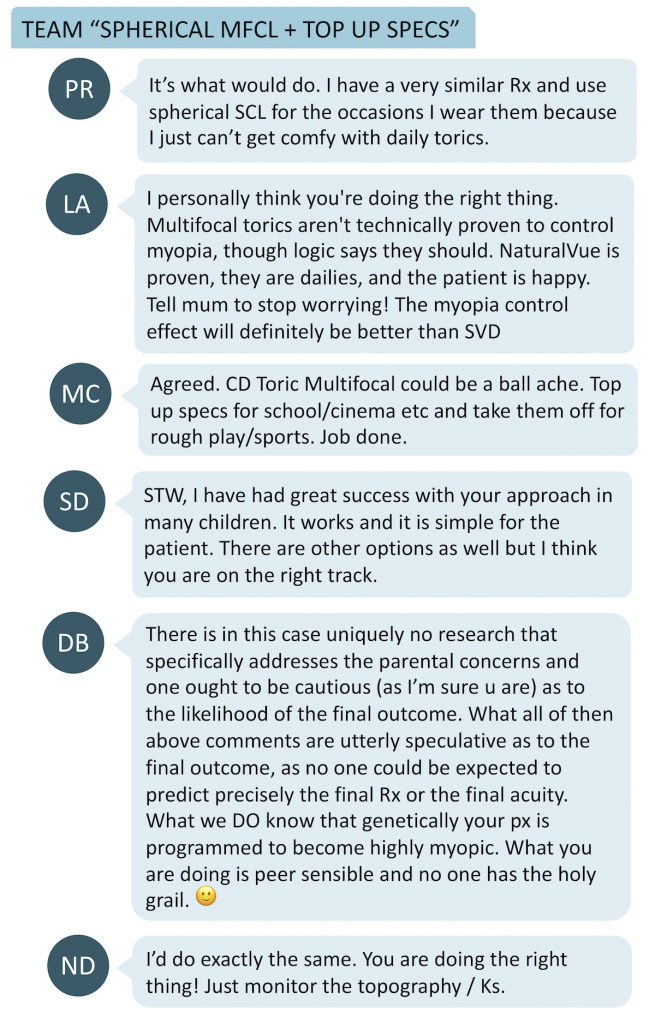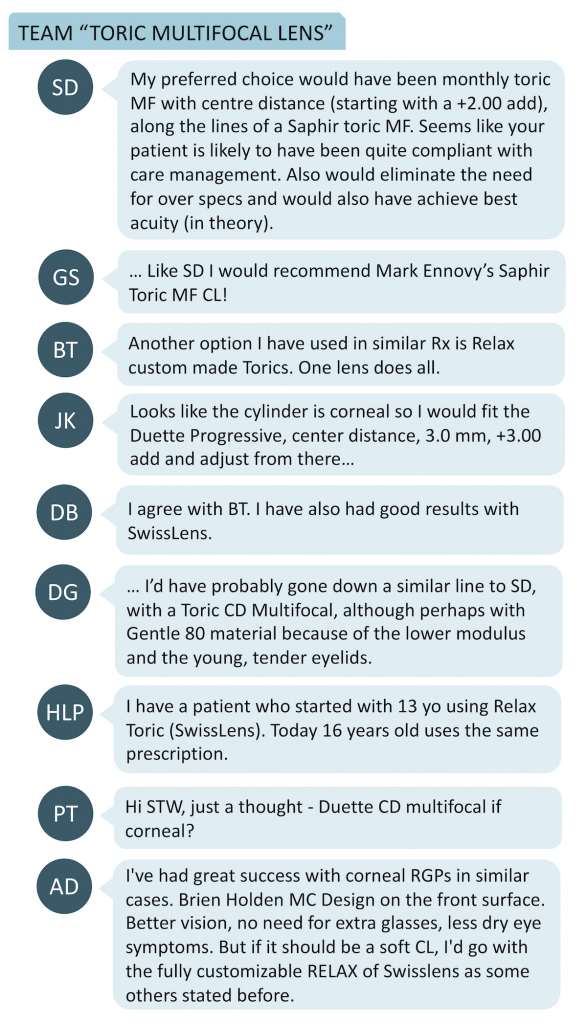A clinical case of high astigmatism with myopia was discussed, where the author STW faced a myopia managing dilemma for a patient whose myopia and astigmatism exceeded the parameters of the more common forms of myopia control with contact lenses. Here’s what the Myopia Profile community suggested in this post,

Which contact lens option to prescribe?
Option 1: Spherical MFCLs + top up specs
This strategy involves using a spherical multifocal / myopia control contact lens (MFCL) with top up specs to account for the over-refraction. The original post author STW chose NaturalVue, which is a daily hydrogel lens with an extended depth of focus design. In addition to NaturalVue, one may opt for other forms of soft multifocal contact lenses or OrthoK.
Pros:
- Spherical contact lenses are generally more comfortable
- Wider variety of lenses to choose from and are easier to fit
- One can easily take off specs for sport
Cons:
- Concern for over-minusing (see below for discussion)
- Some may consider it cumbersome to have two forms of optical correction

Option 2: Toric MFCLs
An alternative to STW’s strategy was to instead prescribe toric multifocal contact lenses. Discussion included considering which lenses were clinically available.
Pros:
- One lens does everything, there no need for top up specs
- Theoretically can achieve the best acuity
Cons:
- Toric lenses can be less comfortable for the patient
- Toric MFCLs can harder to fit as both fit and toric stability must be optimized

Toric multifocal SCLs - what's available
Availability of these lens designs mentioned above will vary by your country of practice.
- Saphir MF by mark'ennovy: A monthly silicon hydrogel lens with a centre distance design.
- Gentle 80 by mark’ennovy: A monthly hydrogel lens with centre distance design
- RelaxTM by Swiss Lens: A centre distance design lens, replaced 3-6 monthly.
- Proclear Toric MFs by CooperVision: A hydrogel monthly multifocal lens with both centre distance and centre near options
- Duette MF by SynergEyes: A hybrid lens (RGP with soft skirt) that is replaced every six months. The GP centre is useful for masking corneal astigmatism
- Toric RGP MFCLs: custom designed by you, with your local lab.
What the research tells us
Currently, there are no studies showing the efficacy of toric MFCLs in slowing myopia progression specifically. The ones that do address toric corrections instead involve OrthoK lenses.
- Chen et al1, Luo et al2 and Lyu et al3 showed that toric OrthoK lenses could slow down axial elongation and provide clear unaided acuity
- Fan et al4 showed that higher astigmatism was associated with more myopic refraction and more myopic shift as well as axial length growth.
Hence, it is important to provide options for controlling myopic progression in children even when their refractive error falls outside the parameter of common contact lens options.
Take home messages
- The conundrum arises when a patient’s refractive error exceeds the parameters available for single corrections: eg. high myopia/astigmatism outside of OrthoK parameters or high astigmatism that excludes daily disposable myopia controlling contact lenses like MiSight or NaturalVue. Hence you will need to consider a combination of optical corrections and myopia control strategies, that may not be currently backed by the evidence.
- At the end of the day, some form of myopia control is always going to be better than a single vision distance correction. Ultimately, it depends on which contact lens to which you have access, and the patient’s lifestyle and preferences, as to which option will suit best.
Read more about multifocal contact lenses for myopia control

About Kimberley
Kimberley Ngu is a clinical optometrist from Perth, Australia, with experience in patient education programs, having practiced in both Australia and Singapore.

About Connie
Connie Gan is a clinical optometrist from Kedah, Malaysia, who provides comprehensive vision care for children and runs the myopia management service in her clinical practice.
This content is brought to you thanks to an unrestricted educational grant from
References
- Chen C, Cheung SW, Cho P. Myopia control using toric orthokeratology (TO-SEE Study). Invest Ophthalmol Vis Sci 2013;54:6510-7. (link)
- Luo M, Ma S, Liang N. Clinical efficacy of toric orthokeratology in myopic adolescent with moderate to high astigmatism. Eye Sci 2014;29:209-13,218. (link)
- Lyu B, Hwang KY, Kim SY, Na KS. Effectiveness of Toric Orthokeratology in the Treatment of Patients with Combined Myopia and Astigmatism. Korean J Ophthalmol 2016;30:434-42. (link)
- Fan DS, Rao SK, Cheung EY, Islam M, Chew S, Lam DS. Astigmatism in Chinese preschool children: prevalence, change, and effect on refractive development. Br J Ophthalmol 2004;88:938-41. (link)











